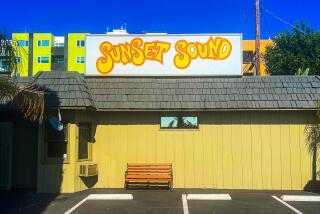Reel and ethereal
The blaze that consumed part of Universal Studios’ back lot Sunday reduced some of Hollywood’s most familiar settings to cinders. Gone are the courthouse from “To Kill a Mockingbird,” the clock tower from “Back to the Future” and the parade route from “The Music Man,” not to mention streetscapes from “Dirty Harry” and “The Sting.” Aside from some YouTube videos, the only remnants of the sets today are the films they appeared in.
But then, that’s what they were intended for. The sets -- serially renovated to stand in for cities across the country -- underwent more face-lifts than the people who acted on them. They might have great sentimental value, but they were worth less in the long run than the images of them that are preserved on film. It’s the simulacrum that’s worth keeping, not the thing itself.
For the record:
2:00 p.m. June 12, 2019Universal Studios fire: A June 3, 2008 editorial about a catastrophic fire at the Universal Studios back lot that had occurred two days earlier stated that Universal Music Group appeared to have lost no irreplaceable master recordings, merely copies. That was based on representations made by a UMG spokesman. New reporting indicates that those representations were false. The company currently is not disclosing the extent of the losses.
That’s why the scariest aspect of the fire, aside from the threat to the people who fought it, was the damage done to a storage vault holding an as-yet-uncertain number of movies and TV shows, plus audiotapes from the studio’s former corporate sibling, Universal Music Group. At this point, it appears that the fire consumed no irreplaceable master recordings, just copies. The studio and the record company both are fortunate enough to have the resources to preserve multiple copies of their source materials around the country. They’ve also been duplicating their recordings in high-quality digital formats, creating additional backups in the event the originals are lost.
Such practices are a welcome change from Hollywood’s first half-century, when the studios were notoriously feckless about preservation. A 1993 report by the librarian of Congress found that half of the feature films produced before 1950 had evaporated, with more than 80% of the films from the 1910s and ‘20s gone forever. Some of the losses were caused by the highly flammable nature of celluloid -- witness the tragic Little Ferry, N.J., blaze in 1937 that destroyed much of Fox’s film library. But many negatives were simply discarded. It wasn’t altruism that turned the moguls around, it was the new markets created by home video and cable movie networks.
Similarly, the drive to digitize film and music libraries was prompted in part by the Internet and high-definition video, which created new opportunities to reuse old material. But the shift to digital masters and the advent of digital production techniques present their own preservation challenges. Hard drives are more fragile than film stock. What’s worse, digital technologies rapidly go obsolete, requiring files to be transferred from medium to medium and from format to format. Still, those are easier threats to manage than fires, earthquakes and other calamities. The sets can go, as long as the illusion they helped create survives.
More to Read
The biggest entertainment stories
Get our big stories about Hollywood, film, television, music, arts, culture and more right in your inbox as soon as they publish.
You may occasionally receive promotional content from the Los Angeles Times.






